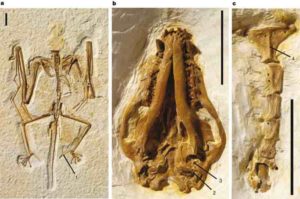
A new species of bat that is 16 million years old has been discovered by an international group that includes University of Valencia lecturers Francisco J. Ruiz Sánchez and Plini Montoya. The finding was made at the palaeontologic site of Mas d’Antolino B, in the town of l’Alcora, and corresponds to the lower Miocene in the Valencia region in Spain.
The identification has been completed thanks to the study of isolated teeth. The study has been published in Earth and Environmental Science Transactions of the Royal Society of Edinburgh.
As well as the two lecturers from the University of Valencia, who belong to the Department of Botany and Geology, the team was comprised by paleontologists Vicente D. Crespo (University of Valencia graduate), the Museo de la Plata museum (Argentina) and Paloma Sevilla, from the Complutense University of Madrid.
The research refers to a set of fossil bat remains from several sites in the town of Alcora (Castellón province), specifically near the Araia d’Alcora village. These fossils, obtained within the framework of digs authorized and funded by the regional Culture Council, have revealed some surprising data that is of great scientific interest. For example, a new species has been identified, and secondly, the finding of a new genus that had heretofore not been discovered in fossil form, which represents a true Lazarus taxon (which means a taxon of which there is no fossil records for a lengthy period of time).
Furthermore, the group of fossil bats represented a typically tropical association, closer to a prior geological period.
At the palaeontological site of Mas d’Antonio B, known since 2008, numerous species of shrews, squirrels, hamsters, dormice, crocodiles and other animals have been found. These animals, framed in an environment that would resemble today’s tropical forest, date back to over 16 million years ago, at the beginning of the era known as Miocene, specifically the “age of mammals” called Aragonian.
The new bat species has been “baptized” with the scientific name Cuvierimops penalveri, in honor of paleontologist Enrique Peñalver, former lecturer at the University of Valencia and recently recognized as one of the best international scientists for his work on fossil insects, and who also carried out studies in the same area where these new findings have taken place.
The new species belongs to the current family of bats called free-tailed or molosid, but curiously belongs to a genus that was thought to have gone extinct ten million years earlier. Said family was predominant in Europe during the Oligocene period, around 23-33 million years ago, but in the early Miocene it had whittled down to a small number of species, and today it is represented by a single species. This is why it is surprising that, of the ten bats discovered at Araia d’Alcora, five are from species that belong to said family of molosids.
Also noteworthy within the recovered collection is a representative of the Chaerephon, whose sole fossils found to date were only 10,000 years old, which gives this discovery the category of Lazarus taxon. Other important bats found at Araia d’Alcora are the molosid Rhizomops, which is the first time it has appeared in the lower Miocene, and the vespertilionid Submyotodon, found for the first time in a palaeontologic site in the Iberian Peninsula.
In this era, the environment in Araia corresponded to a tropical forest, with meadows that would have been located around a large lake that takes up most of the current towns of l’Alcora, Ribesalbes and Fanzara. The tropical environment of the area during the lower Miocene is confirmed by the abundance of molosid bats, which today are common in tropical climate areas, such as Center and South America, Ethiopia, India or Australia.
Obtaining the fossil remains of small mammals required a thorough process of cleaning-sieving of several tons of sediment, as well as grading the abundant waste obtained at the end of the process. Studying the fossil teeth was done using several techniques, including electronic microscopy.
Note: The above post is reprinted from materials provided by Asociacion RUVID.










